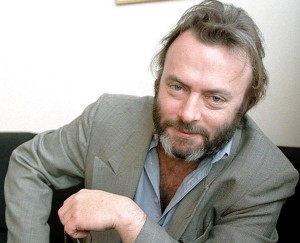Mother Teresa
 While Christopher Hitchens offered up in-depth essays and critiques on many notable figures and political movements, hardly any public figure saw as much criticism as Mother Teresa, who Hitchens based several essays and his novel "The Missionary Position" on. His views on Mother Teresa didn't focus entirely on her character, rather extended to highlighting the praise and sainthood that she received by believers and non-believers alike, while he felt that she was not bereft of faults. Hitchens believed that the idolization that was placed on her wasn't earned and that she did more harm than good, particularly with the horrid conditions of the hospice that she ran and her stark opposition of contraception, wherein she compared the usage of contraceptives to abortion.
While Christopher Hitchens offered up in-depth essays and critiques on many notable figures and political movements, hardly any public figure saw as much criticism as Mother Teresa, who Hitchens based several essays and his novel "The Missionary Position" on. His views on Mother Teresa didn't focus entirely on her character, rather extended to highlighting the praise and sainthood that she received by believers and non-believers alike, while he felt that she was not bereft of faults. Hitchens believed that the idolization that was placed on her wasn't earned and that she did more harm than good, particularly with the horrid conditions of the hospice that she ran and her stark opposition of contraception, wherein she compared the usage of contraceptives to abortion.
In 1994, Hitchens explored Mother Teresa's character in depth, as well as the fervor surrounding her works. Hitchens points out that even those who are non-believers view Mother Teresa as an untouchable figure that should not receive any criticism. One such account of "tawdry media hype" that Hitchens noted was indicative of the hyperbolic views people had of Mother Teresa started with the visit of British journalist Malcolm Muggeridge to Calcutta in 1969. The photographer, Ken McMillan, took a large number of photos while visiting Mother Teresa with the usage of new Kodak film. Upon returning from the visit, the photos were developed and placed onto a screen for Muggeridge and others to see. The photos were clearer than normal and displayed every minute detail. While the photographer attributed this to the new film, Malcolm Muggeridge believed this to be a divine light brought about by Mother Teresa herself. It is believed that this is what started the Western adoration of Mother Teresa.
It was because of this account and many others that Hitchens aimed to shine a light on what Mother Teresa was really like. One of the primary issues Hitchens had with the care she provided within her hospices was the fact that hardly any medical care was actually provided to patients. Even those that had relatively common health problems weren't given proper antibiotics and other medicine, which only served to worsen their rather benign illnesses. Hitchens himself visited the hospice in Calcutta in 1980. During this visit, Mother Teresa looked upon the small cots in the hospice and proclaimed to Hitchens "This is how we fight contraceptives and abortions in Calcutta." Hitchens argued that the most damaging aspect of Mother Teresa's teachings was her crusade on abortion and her beliefs that it was an unforgivable thing to do, while also campaigning against using birth control and contraceptives. He also argued that she was hypocritical in this matter, largely because she commonly claimed that she had very little to do with politics, yet turned the ear of a number of the world's largest politicians, including Ronald Reagan and Margaret Thatcher, even going so far as to push the latter towards siding with a bill that would limit abortion.
Hell's Angel
In 1994 Hitchens produced this documentary for Channel 4 in the UK.
The Missionary Position
 In 1995, Hitchens wrote this essay settings to uncover the true portrait of who Mother Teresa was, and whether or not her idolization was earned. His findings were exceedingly critical of the rather ruthless "care" he believe that she doled out within her hospitals. Hitchens himself professed to be more concerned with how the public viewed her than in actually attacking her character. While there were many critics who praised this fiery and risky essay, there were just as many who believe that the content within went too far. However, this criticism simply emboldened Hitchens, as he went on to write many more essays and novels, including Letters to a Young Contrarian, Arguably: Essays by Christopher Hitchens, Why Orwell Matters and Hitch 22: The Memoir, to name but a few. The Missionary Position on Amazon
In 1995, Hitchens wrote this essay settings to uncover the true portrait of who Mother Teresa was, and whether or not her idolization was earned. His findings were exceedingly critical of the rather ruthless "care" he believe that she doled out within her hospitals. Hitchens himself professed to be more concerned with how the public viewed her than in actually attacking her character. While there were many critics who praised this fiery and risky essay, there were just as many who believe that the content within went too far. However, this criticism simply emboldened Hitchens, as he went on to write many more essays and novels, including Letters to a Young Contrarian, Arguably: Essays by Christopher Hitchens, Why Orwell Matters and Hitch 22: The Memoir, to name but a few. The Missionary Position on Amazon

